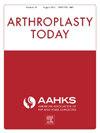Preoperative Predictors of Soft Tissue Releases Required for Femoral Exposure in Direct Anterior Total Hip Arthroplasty
IF 1.5
Q3 ORTHOPEDICS
引用次数: 0
Abstract
Background
Sequential soft tissue releases are utilized in direct anterior approach (DAA) total hip arthroplasty (THA) as incomplete femoral exposure may lead to complications. This study identifies patient-specific parameters associated with soft tissue releases required for femoral exposure.
Methods
A retrospective review was conducted on 133 patients (150 hips) who underwent primary THA via DAA with a single surgeon. Preoperative radiographic measurements included ilium-ischial ratio (IIR), anterior superior iliac spine to tip of the greater trochanter (AGT), femoral neck-shaft angle (FNA), and articulotrochanteric distance (ATD). Operative reports were reviewed and a multinomial logistic regression model was conducted to identify associations of soft tissue releases.
Results
Among patients, 12 (8%) had no release, 94 (62%) had conjoined release, 44 (29%) had conjoined and piriformis releases. Multivariate analysis revealed IIR (OR [odds ratio] 1.68, P = .008), right laterality (OR 7.41, P = .025), and body mass index (BMI) (OR 1.26, P = .041) were associated with conjoined release. BMI (OR 1.51, P = .001), right laterality (OR 7.63, P = .038), and IIR (OR 2.06, P = .001) were also associated with piriformis release. There were no statistically significant differences between AGT, FNA, or ATD between groups.
Conclusions
Patients with increased ilium to ischial ratio, right laterality, and larger BMI were associated with greater number of soft tissue releases for adequate femoral exposure. Surgeons may consider these factors to anticipate femoral releases or challenging femoral exposure in direct anterior total hip arthroplasty.
直接前路全髋关节置换术中股骨暴露所需软组织释放的术前预测因素。
背景:在直接前路(DAA)全髋关节置换术(THA)中,由于股骨不完全暴露可能导致并发症,序贯软组织释放被应用。本研究确定了与股骨暴露所需的软组织释放相关的患者特异性参数。方法:对133例(150髋)由同一位外科医生通过DAA行原发性THA的患者进行回顾性分析。术前x线测量包括髂骨-坐骨比(IIR)、髂前上棘与大转子尖端(AGT)、股骨颈轴角(FNA)和关节-粗隆距离(ATD)。我们回顾了手术报告,并采用多项逻辑回归模型来确定软组织释放的关联。结果:无释放12例(8%),连体释放94例(62%),连体和梨状肌释放44例(29%)。多因素分析显示,IIR (OR[比值比]1.68,P = 0.008)、右侧偏侧(OR 7.41, P = 0.025)和体重指数(BMI) (OR 1.26, P = 0.041)与联合释放相关。BMI (OR 1.51, P = .001)、右侧偏侧(OR 7.63, P = .038)和IIR (OR 2.06, P = .001)也与梨状肌释放相关。两组间AGT、FNA、ATD差异无统计学意义。结论:髂骨与坐骨比增加、右侧偏侧和较大BMI的患者与足够股骨暴露的软组织释放次数较多相关。在直接前路全髋关节置换术中,外科医生可能会考虑这些因素来预测股骨松脱或挑战股骨暴露。
本文章由计算机程序翻译,如有差异,请以英文原文为准。
求助全文
约1分钟内获得全文
求助全文
来源期刊

Arthroplasty Today
Medicine-Surgery
CiteScore
2.90
自引率
0.00%
发文量
258
审稿时长
40 weeks
期刊介绍:
Arthroplasty Today is a companion journal to the Journal of Arthroplasty. The journal Arthroplasty Today brings together the clinical and scientific foundations for joint replacement of the hip and knee in an open-access, online format. Arthroplasty Today solicits manuscripts of the highest quality from all areas of scientific endeavor that relate to joint replacement or the treatment of its complications, including those dealing with patient outcomes, economic and policy issues, prosthetic design, biomechanics, biomaterials, and biologic response to arthroplasty. The journal focuses on case reports. It is the purpose of Arthroplasty Today to present material to practicing orthopaedic surgeons that will keep them abreast of developments in the field, prove useful in the care of patients, and aid in understanding the scientific foundation of this subspecialty area of joint replacement. The international members of the Editorial Board provide a worldwide perspective for the journal''s area of interest. Their participation ensures that each issue of Arthroplasty Today provides the reader with timely, peer-reviewed articles of the highest quality.
 求助内容:
求助内容: 应助结果提醒方式:
应助结果提醒方式:


